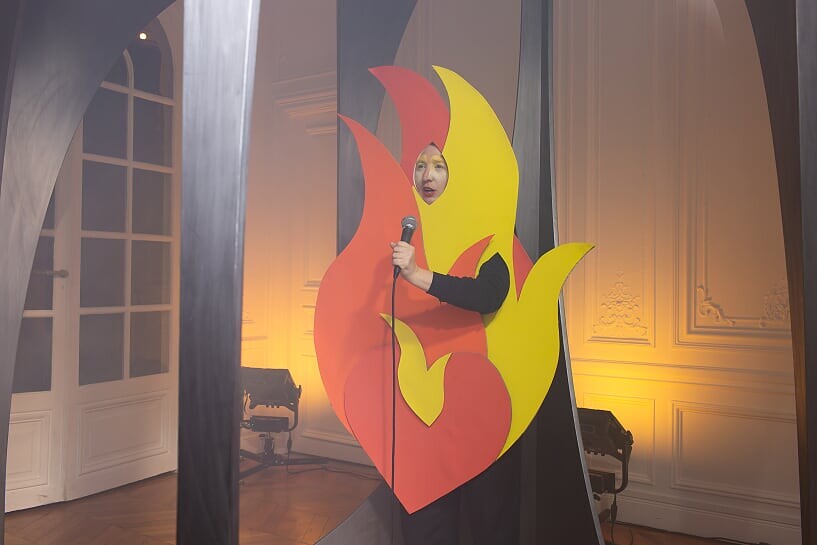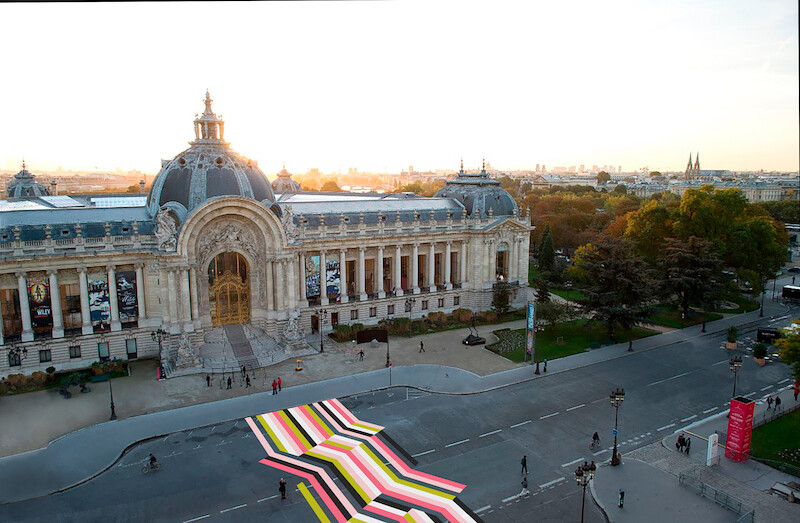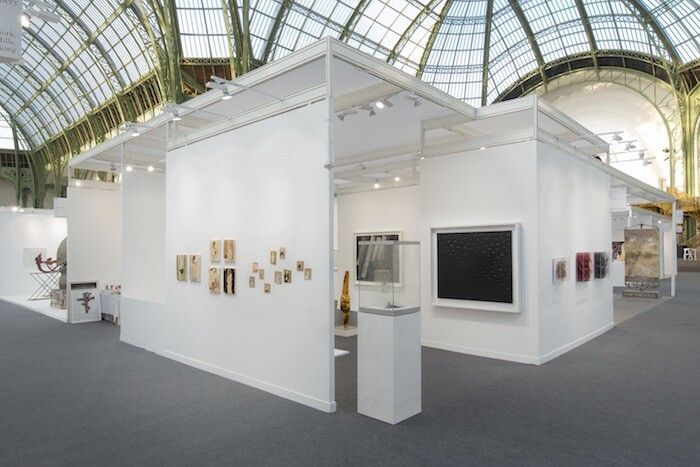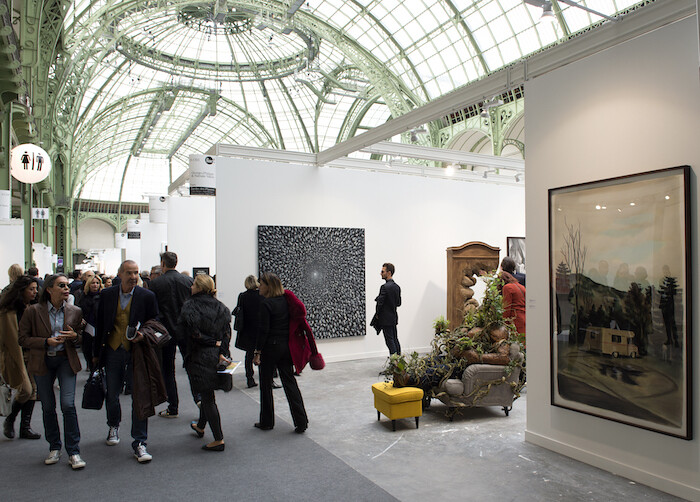Categories
Subjects
Authors
Artists
Venues
Locations
Calendar
Filter
Done
October 22, 2019 – Feature
Paris Roundup
Sofia Gotti

The most useful warning ever given to me while studying the Parisian avant-garde was “don’t forget they were all sleeping with each other!” A vital reminder that modern art was not the product of a pure and original creative act, but rather the consequence of cross-pollination that occurred thanks to friendships, sexual relations, and confrontations. That idea of purity and originality, still often fed to modern art scholars like mother’s milk, is a construction deeply compromised by power, politics, and, yes, sexuality. This context is inescapable, especially when wandering through FIAC at the Grand Palais. A leftover of the Exposition Universelle of 1900, the Grand Palais is a paradigmatic example of how France displayed its hegemonic power over culture and technology.
As a scholar of feminism and decolonialism, I am determined to deconstruct the canon I was handed. I resolved during my visit to focus on practices that signal a transformation in mainstream narrative and to ignore outdated (albeit seductive) presentations dedicated to contemporary mainstays, or booths like Gagosian’s all-male display dedicated to artists who spent time on the French Riviera. My main inquiry is, how are artists articulating the notions of impurity, disjunction, difference, and desire this week in …
October 22, 2018 – Feature
Paris Roundup
Lauren Mackler

Stamina This is by no means comprehensive, so I’ll get my highlights out of the way. Rounding down, and starting with the experiential: I found the hunt for the various venues of Avant-Première compelling. This casually organized event was comprised of small Parisian galleries and emerging ventures opening their shows a few days before the fairs and driving traffic from post-Frieze London. Out-of-towners (this year, Los Angeles galleries) were embedded in unconventional spaces: up spiraling staircases and behind doorbell-laden portals. At the Beaux Arts, Nairy Baghramian’s exhibition of self-reflexive, materially seductive sculptures—in which shims and buffers, made of aluminum and cork, held up large unwieldy shapes—defied definitions of form; at Balice Hertling’s Marais space, Isabelle Cornaro’s detail-oriented objects and careful placement evoked stilled narratives; small captivating pictures by Lisetta Carmi hung quietly in Galerie Antoine Levi, capturing tender backstage scenes between sex-workers, trans lovers, and friends. A night, at the legendary club Les Bains Douches, where the smell of chlorine and the reflection of the indoor pool added to the intemperance of its crowd; a day prior, at a small hotel lounge, when our bartender told us that Oscar Wilde died just over there, a few feet away from our …
October 20, 2017 – Feature
Paris Roundup
Tom Jeffreys

The wide eyes and open mouth of a child are a reminder that, even at art fairs, there is still space for the occasional moment of wonder. The girl has good taste: she’s enthralled by Endless (2012), a sculpture by Claire Morgan at the FIAC booth of Galerie Karsten Greve. A three-dimensional grid of dead flies has been suspended in mid-air on vertical lines of nylon weighted with little pieces of lead. Around them, similarly hung dandelion heads form a slim, delicate frame. It is a gossamer-light and enchanting piece, whose dark eco-political agenda has been lent new urgency by recent research into insect decline.
Animals seem, nonetheless, to be scampering throughout Paris this week. Also at FIAC, London’s Sadie Coles’ booth lures visitors in with Rudolf Stingel’s Untitled (2015), a black-and-white painting of a photograph of a squirrel. At the Musée de la Chasse et de la Nature, Sophie Calle interweaves the personal, the political, and the philosophical through a series of interventions, including covering the museum’s famous stuffed bear in a white shroud. Especially intriguing is a series of photographs (“Liberté Surveillée,” 2014) of deer, pheasants, and hares taken at night by automated cameras sited on the bridges and …
October 20, 2016 – Review
FIAC and Paris Internationale
Sabrina Tarasoff

Adam Curtis’s new film HyperNormalisation (2016) is about the diffusion of power through the manipulation of the media. It posits that politicians adopted the basic tenets of techno-utopianism to create an oversimplified worldview of a global economic and political landscape which had become overwhelmingly complex. The creation of mass-mediated, caricatured villains, alongside the triumph of algorithms that create an echo chamber of opinion, reify the sense of felt anxiety and support new forms of power. Participation reinforces these structures, maintaining the fantasy of status quo in society even as we feel assaulted by the unpredictable.
Art fairs seem to operate in similar ways, spreading states of disconcert and powerlessness which reify comparable anxieties about the demands of the market whilst providing the grounds on which to idly fantasize about structures which could undercut the existing order. While the critique of fairs—writers pointing fingers at excesses, entanglements, or trends—only exacerbates the problem, we all fall into the trap of assuming that power lies in some displaced “other,” ignoring how our collusion enables the structures we seek to oppose. Display, discourse, commerce, and criticism all consolidate the fair’s encompassing power by refusing to acknowledge how normalized its ebbs and flows have become.
Alternatives do …
October 23, 2015 – Feature
FIAC, Paris Internationale, and Paris Roundup
Claire Moulène

Emancipation. Such could be the keyword of this FIAC week in Paris. Since its 2003 takeover by the duo Martin Béthenod and Jennifer Flay (and then by the latter, on her own), the grand old lady that is FIAC has regained the golden splendor of the Grand Palais and the heart of the French capital. This move also allowed FIAC to return to the chessboard of the major international circuit, skillfully playing on both the modern and the contemporary tables. Yet this year the fair, upright on its two legs, flamboyant but not flambé, has been stabbed in the back. It was not betrayed by its detractors or by the “refusés” (and many were excluded from the final selection, which decreased to 172 from last year’s 191 participating galleries) but rather by new and timely independent initiatives in Paris, shaped by the desire for an overhaul of the landscape.
The first breakaway operation is Paris Internationale, which leaves all the other off fairs in the dust. Even FIAC’s sister fair, “Officielle”—founded in 2014 to host younger galleries—has a grim look this year, with the exception of a small handful of stands. Among them is Paris’s Galerie Olivier Robert, which presents a …